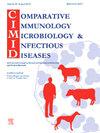First report on the molecular characterization and phylogenetic analysis of meq oncogene from virulent serotype-1 Marek's disease virus in laying hen flocks and broiler breeders in Algeria
IF 2
3区 农林科学
Q4 IMMUNOLOGY
Comparative Immunology Microbiology and Infectious Diseases
Pub Date : 2025-05-11
DOI:10.1016/j.cimid.2025.102358
引用次数: 0
Abstract
Marek's disease (MD) is a highly contagious viral infection in poultry, caused by Gallid alphaherpesvirus 2 (GaHV-2), better known as serotype 1 of Marek’s disease virus (MDV-1). It is one of the most concerning diseases in the poultry industry due to its significant economic impact. The disease mainly affects chickens, although other avian species can also be affected. The objective of this study was to examine the occurrence of Marek's disease virus (MDV) in fourteen poultry farms in Algeria through autopsy, histopathological analysis and molecular characterization of Marek's disease virus. This study represents one of the first investigations combining macroscopic, histopathological, and molecular analyses to assess the prevalence and genetic diversity of Marek's disease virus in Algerian poultry farms. A survey to assess the current occurrence of Marek's disease in poultry farms in Algeria was conducted from June to December 2024. Tissue samples were collected from 70 chickens, including 35 from broiler breeder farms and 35 from layer farms. Macroscopic and histopathological examinations were performed. Macroscopic pathological alterations, such as hepatomegaly, splenomegaly, renal hypertrophy, and sciatic nerve enlargement with follicular atresia and lymphomatous infiltration, were observed. Histopathological analyses revealed diffuse and multifocal whitish infiltration of the spleen, neoplastic infiltration of the liver, intrafollicular lymphoid infiltration in the bursa of Fabricius, and infiltration in the sciatic nerves. The molecular characterization of MDV through PCR amplification and sequencing of the meq gene provides novel insights into the circulating strains in Algeria. The samples were screened by PCR amplification of the meq gene. Additionally, we sequenced the meq gene from five samples per flock, and a phylogenetic tree was constructed using the deduced amino acid sequences of the meq gene. This study is the first to identify and classify MDV strains in Algerian broiler breeder and laying hen farms, revealing the presence of very virulent (vv) MDV pathotypes. Marek's disease remains a major veterinary and economic challenge in the poultry industry, requiring ongoing research to better understand its mechanisms, genetic variations, and control methods.
阿尔及利亚产蛋鸡群和肉鸡种鸡强毒1型马立克病病毒meq致癌基因的分子特征和系统发育分析
马立克病(MD)是一种在家禽中高度传染性的病毒感染,由Gallid α疱疹病毒2 (GaHV-2)引起,也就是众所周知的马立克病病毒(MDV-1)血清型1。由于其显著的经济影响,它是家禽业中最令人关注的疾病之一。这种疾病主要影响鸡,尽管其他鸟类也会受到影响。本研究的目的是通过尸检、组织病理学分析和马立克病病毒的分子特征来检查阿尔及利亚14个家禽养殖场马立克病病毒(MDV)的发生情况。本研究是首次结合宏观、组织病理学和分子分析来评估阿尔及利亚家禽养殖场马立克病病毒流行率和遗传多样性的研究之一。于2024年6月至12月对阿尔及利亚家禽养殖场进行了马立克病调查。采集了70只鸡的组织样本,其中肉鸡种鸡场35只,蛋鸡场35只。进行了肉眼和组织病理学检查。肉眼可见肝、脾、肾肥大、坐骨神经肿大伴滤泡闭锁及淋巴瘤浸润等病理改变。组织病理学分析显示脾脏弥漫性和多灶性白色浸润,肝脏肿瘤浸润,法氏囊滤泡内淋巴浸润,以及坐骨神经浸润。通过PCR扩增和meq基因测序的MDV分子特征为阿尔及利亚流行菌株提供了新的见解。采用meq基因PCR扩增法筛选样品。此外,我们对每群5个样本的meq基因进行了测序,并利用推导出的meq基因氨基酸序列构建了系统发育树。这项研究首次在阿尔及利亚肉鸡养殖场和蛋鸡养殖场对MDV毒株进行鉴定和分类,揭示了非常毒力(vv) MDV致病型的存在。马立克氏病仍然是家禽业面临的主要兽医和经济挑战,需要进行持续的研究,以更好地了解其机制、遗传变异和控制方法。
本文章由计算机程序翻译,如有差异,请以英文原文为准。
求助全文
约1分钟内获得全文
求助全文
来源期刊
CiteScore
4.60
自引率
0.00%
发文量
102
审稿时长
40 days
期刊介绍:
Comparative Immunology, Microbiology & Infectious Diseases aims to respond to the concept of "One Medicine" and to provide a venue for scientific exchange. Based on the concept of "Comparative Medicine" interdisciplinary cooperation between specialists in human and animal medicine is of mutual interest and benefit. Therefore, there is need to combine the respective interest of physicians, veterinarians and other health professionals for comparative studies relevant to either human or animal medicine .
The journal is open to subjects of common interest related to the immunology, immunopathology, microbiology, parasitology and epidemiology of human and animal infectious diseases, especially zoonotic infections, and animal models of human infectious diseases. The role of environmental factors in disease emergence is emphasized. CIMID is mainly focusing on applied veterinary and human medicine rather than on fundamental experimental research.

 求助内容:
求助内容: 应助结果提醒方式:
应助结果提醒方式:


